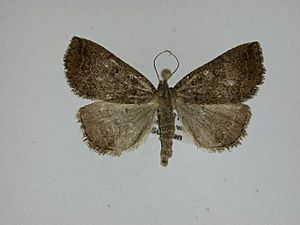Variable zanclognatha facts for kids
Quick facts for kids Variable zanclognatha |
|
|---|---|
 |
|
| Scientific classification | |
| Synonyms | |
|
The Variable Zanclognatha, also known by its scientific name Zanclognatha laevigata, is a small and interesting moth. It's often called a "litter moth" because its young, known as larvae, play a role in breaking down dead plant material. This moth was first described by a scientist named Augustus Radcliffe Grote in 1872.
Contents
About the Variable Zanclognatha Moth
The Variable Zanclognatha is a member of the Erebidae family, which is one of the largest families of moths. Within this family, it belongs to a smaller group called Herminiinae, often referred to as litter moths. These moths are important for the environment because their larvae help recycle nutrients by eating dead leaves and other plant parts.
What Does It Look Like?
This moth is fairly small. When its wings are spread out, its wingspan (the distance from one wingtip to the other) is about 30 millimeters. That's about the length of a standard paperclip! The name "variable" in its common name suggests that its appearance might change slightly from one individual moth to another.
Where Does It Live?
The Variable Zanclognatha moth can be found across a wide area of North America. Its habitat stretches from Manitoba in Canada, all the way east to Nova Scotia. Southward, you can find it as far as Florida and Missouri in the United States. This wide range means it can adapt to different environments.
What Does It Eat?
Unlike some moths that feed on nectar as adults, the larvae (the caterpillar stage) of the Variable Zanclognatha moth have a unique diet. They feed on detritus, which is a fancy word for decaying organic matter. This mainly includes dead leaves and other bits of dead plants found on the ground. By eating these materials, the larvae help to clean up the forest floor and return nutrients to the soil.
Life Cycle of the Moth
The Variable Zanclognatha moth typically has one generation per year. This means that from egg to adult, the entire life cycle happens once within a year. The female moth lays eggs, which hatch into larvae. These larvae grow by eating dead leaves. After a period of growth, the larvae change into pupae, and then finally emerge as adult moths, ready to start the cycle again.

